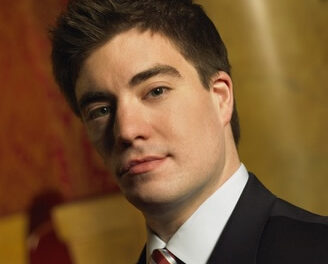The March 12 recital by soprano Catherine Charlton, accompanied by harpist Emily Laurance and flutist Ann Cameron Pearce, in Smedes Parlor at St Mary’s School, opened with a group of four Spanish songs whose piano parts were transcribed for harp, two each by Granados (“El Majo discreto” and “No lloréis, ojuelos”) and Rodrigo (“¿Con qué la lavaré?” and “¿De dónde venís, amore?”) alternating. Charlton is an animated singer with generally very clearly enunciated diction, and her lively interpretations were greeted with warm applause from the audience after each song.
After some good oral comments and a request that the audience hold its applause until the end of each group, Charlton sang Ravel’s Cinq mélodies populaires grecques (1905), heard in UNC’s Hill Hall during Elizabeth Linnartz’ February 19 recital (also reviewed in these pages). Charlton’s French diction is as good as her Spanish, and she made the songs come alive. The harp transcription of the piano part was by Carlos Salzedo and received the composer’s seal of approval.
After further fine commentary by Charlton about the composers and their musical styles came a pair of songs by Albert Roussel, Deux poèmes de Ronsard , Op. 26, with flute accompaniment, composed in 1919. These (“Rossignol, mon mignon” and “Ciel, aer, et vens”) are quieter, in marked contrast with the previous two groups, and the music is much more modern, perhaps because it is original rather than derived from folk songs. The flute line is quite independent of the vocal line, giving the latter little support, almost as if it has a mind of its own. The performance was lovely.
These were followed by Saint-Saëns’ “Une flûte invisible” (1885), on a poem by Victor Hugo, which added harp as a second accompanying instrument, playing the piano line, for a delightful and very lyrical rendering. Closing the first half was a charming and appropriately soothing flute and harp transcription of Fauré’s “Berceuse”, originally for violin and piano, and arranged for this instrumentation by Donald Peck, Principal Flutist of the Chicago Symphony Orchestra, according to comments by Pearce.
After intermission, Philip Cannon’s Cinq chansons de femme (1951), also heard in Linnartz’ recital, was presented. Charlton varied her vocal tone and dramatization appropriately for the character in each of the texts. It was interesting to hear this cycle, previously unfamiliar to me, so soon after my introduction to it by Linnartz. It gave yet another opportunity for comparison, or perhaps more aptly put, stark contrast of venues. It seemed so much more appropriate and enjoyable in the intimate salon-style Smedes Parlor setting than in the formal concert-style Hill Hall Auditorium, though I would be hard put to declare one interpretation superior to the other.
This cycle was followed in turn by Three Irish Folksong Settings (1990) by John Corigliano. The accompanying flute line seemed to have even more a mind of its own here than in the Roussel, creating some dissonances and, at times, almost a dueling effect against the familiar tunes (“The Salley Gardens,” “The Foggy Dew” and “She Moved Through the Fair”) in the vocal line.
Another quiet piece for flute and harp, “Greensleeves Variations” by F. Leary and Dewey Owens followed. Charlton then returned for a truly beautiful rendition of Vaughan Williams’ “The Unquiet Grave,” a lovely piece with a late-Victorian feel. It is good that this material is no longer being totally avoided. This was immediately followed by Thomas Pasatieri’s “Beautiful the Days” with harp accompaniment. Charlton then announced the replacement of the scheduled Quilter song, “Love’s Philosophy,” by what was planned as an encore, Liza Lehmann’s “There are fairies in the bottom of our garden” which she sang from memory, having used scores on a stand in front of her for the rest of the evening. This allowed her the greatest freedom for animated interpretation of the evening as well, and brought the program to a fine close.
This was a lovely recital, well performed in spite of the short-notice replacement of the scheduled harpist, Winifred Garrett, who had to withdraw due to family emergencies. Laurance had to use the services of a page-turner because there simply wasn’t time for her to learn all the new material, but she acquitted herself very well; this reviewer did not notice anything amiss.
The evening would have been much finer, however, if the printed program and accompanying materials had been of as high a quality as the material chosen and the performances given. There were virtually NO texts but merely loose prose translations for songs in languages other than English, and, except for Ronsard in the Roussel title, the poets were not named. There were good artist bios, but NO notes about the composers (although life dates were beneath their names) or the works. No dates of composition were given. Neither were Opus numbers with one exception which wasn’t quite right: the Roussel cycle was listed as “Op. 26, No. 2”! Many songs do not have Opus numbers, of course, but they should be given when they do: the Opus applies to the cycle, and the Number to the order of the songs therein. Titles should be given in the original language, and were with one curious exception: the Ravel was listed as “Five Greek Folk Songs,” although the titles of the songs themselves were in French. All accents were missing and there were errors in foreign language punctuation (all corrected herein). “Program” had a capital “p” but “intermission” a lower-case “i”. This is all carelessness and easily avoided-and it should be, especially in the setting of an educational institution. A line at the end of the program indicated that it “was made possible through a generous donation by Dr. Marvin and Elizabeth Brown.” They are longtime supporters-and attendees-of musical activities at St. Mary’s and deserve our heartfelt thanks for both.











